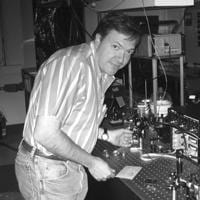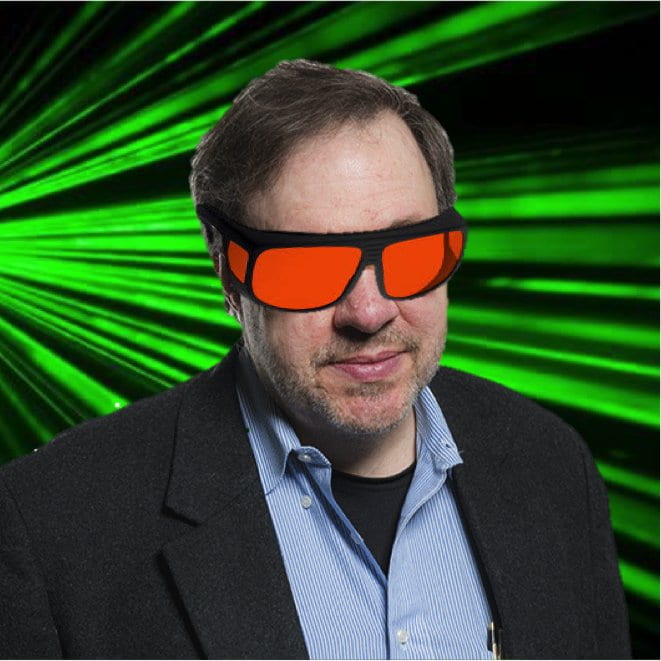Norbert Scherer
Principal investigator

Norbert Scherer
Professor of Chemistry
Professor, University of Chicago, 1997 – present
Assistant Professor, University of Pennsylvania, 1982 – 1997
NSF Postdoctoral Fellow, University of Chicago, 1989 – 1992
PhD in Chemistry, California Institute of Technology, 1989
BS in Chemistry, University of Chicago, 1982
![]() nfschere@uchicago.edu
nfschere@uchicago.edu
Research Interests
Research in the Scherer group aligns with Shakespeare’s famous line from The Tempest, “What’s past is prologue.” Our research builds on exciting past research, but strives to explore new unanswered questions in three areas: formation, structure and dynamics in driven nonequilibrium optical matter; optical magnetism and novel collective excitations and spectroscopy of nanoplasmonic-based meta-materials; and connecting transport in single and multi-cellular systems to function. The research is problem-oriented but involves a wide range of experimental and simulation methods. Depending on the system and problem the measurements may be with femtosecond time resolution or the processes may take days. Each experimental problem has a corresponding theory/simulation component done either within the group or through collaborations. Our research has and continues to involve development of new methods, including: advances in ultrafast lasers and nonlinear spectroscopy; pointillist, nonlinear and 4D microscopy; theory and methods for image analysis; and coupled electrodynamics and Langevin dynamics simulations.
Self-organizing Optical Matter Structures and Machines
Can one build and power nanoscale machines with light (electromagnetic fields) to do work? Our recent research has pioneered the self-organization of ordered assemblies of nanoparticles into optical matter structures that undergo directed motion by linear or angular momentum conversion. Plasmonic metal nanoparticles (e.g. spheroids, bipyramids, rods, wires, etc.) strongly scatter light. The resultant interference of incident and scattered light creates modulated optical fields on the length scale of light (d ~ λ) allowing the particles to optically bind electrodynamically. Optical matter structures of few to many nanoparticle constituents exhibit new and novel properties: they move as rigid bodies; behave as soft active matter; exhibit negative torque; and serve as analogs of chemical exchange and isomerization reactions. The close coupling of experiments and electrodynamics simulations allowed creating the first nanoscale optical matter machine that works by conversion of spin to orbital angular momentum. We are exploring how the long range and many-body nature of the interactions of the optical matter constituents can result in structures that are different that those expected from localized bonding in chemical systems.
- Potential Energy Surfaces and Reaction Pathways for Light-Mediated Self-Organization of Metal Nanoparticle Clusters. Zijie Yan, Stephen K. Gray, and Norbert F. Scherer, Nature Communications, vol. 5, published online (5/2/2014) DOI: 10.1038/ncomms4751 (Link)
- Reactive optical matter: light-induced motility in asymmetric nanoscale scatterers, Yuval Yifat, Delphine Coursault, Curtis W. Peterson, John Parker, Ying Bao, Stephen K. Gray, Stuart A. Rice, and Norbert F. Scherer, Light: Science & Applications volume 7, Article number: 105 (12/2018), DOI 10.1038/s41377-018-0105-y. (Link)
- Crossover from positive to negative optical torque in mesoscale optical matter, Fei Han, John A. Parker, Yuval Yifat, Curtis Peterson, Stephen K. Gray, Norbert F. Scherer & Zijie Yan, Nature Communications, Article Number 4897 (2018) 9:4897, (11/2018). doi.org/10.1038/s41467-018-07376-7. (Link).
- Direct Visualization of Barrier Crossing Dynamics in a Driven Optical Matter System, Patrick Figliozzi, Curtis W. Peterson, Stuart A. Rice, and Norbert F. Scherer, ACS Nano, 2018, 12 (6), pp 5168–5175, (4/2018). DOI: 10.1021/acsnano.8b02012 (Link).
- An Optical Matter Machine: Angular Momentum Conversion by Collective Modes in Optically Bound Nanoparticle Arrays, John Parker, Curtis W. Peterson, Yuval Yifat, Stuart A. Rice, Zijie Yan, Stephen K. Gray, and Norbert F. Scherer, Physical Review X, under review (2019).
Enhanced Photonic Properties in Self-organized Optical Matter Structures
We have used the self-organized 2D optical matter lattices of metal nanoparticles in solution as templates for “co-trapping” of single semiconductor quantum dots into these nanoparticle lattices and are exploring the Purcell-type (de-)enhancements of their radiative properties in the self-organized photonic structures. Control of these properties could lead to superraidance and stimulated emission that is fundamental for and nascent to lasing. Furthermore, these hybrid optical matter materials are reminiscent of strongly coupled plasmon-exciton quantum materials that we studied theoretically that exhibit entanglement.
- Hierarchical Photonic Synthesis of Hybrid Nanoparticle Assemblies. Zijie Yan, Uttam Manna, Wei Qin, Art Camire, Philippe Guyot-Sionnest, and Norbert F. Scherer, J. Phys. Chem. Lett, 4, 2630-2636 (2013). DOI:10.1021/jz401007t (Link).
- Ultrafast Reversal of a Fano Resonance in a Plasmon-Exciton System. Raman A. Shah, Norbert F. Scherer, Matthew Pelton, and Stephen K. Gray, Phys. Rev. B, 88(7), 075411 (2013). DOI:10.1103/PhysRevB.88.075411 (Link).
- Evidence for a Diffusion-Controlled Mechanism for Fluorescence Blinking of Colloidal Quantum Dots. Matthew Pelton, Glenna Smith, Norbert F. Scherer, and Rudolph A. Marcus, Proc. Natl. Acad. Sci. U.S.A., 104, 14249-14254 (2007) (Link).
Novel Exciatations and Spectroscopy of Nano-Meta-Materials with Optical Vector Beams
What novel excitations become possible with vector beams of light? Can we discover new design principles for nanoparticle-based meta-materials that control properties of coherent light? Meta-materials are structures with sub-wavelength features and constituent elements that strongly interact to give rise to new properties. Our interest is in new optical excitations that allow controlling the properties of light that interacted with the meta-atoms and meta-materials. In addition to materials design, we are also interested in the novel excitations that are made possible when the polarization prosperities of focused beams of light are no longer homogeneous, scalar beams. Excitations termed “dark modes” with scalar beams of light are made bright with vector beams. Azimuthally polarized beams that exhibit instantaneous curl begets optical magnetism, magnetic excitations at optical frequencies, in meta-atoms. As a result, the rules governing matter-radiation interactions for meta-materials and vector beams are entirely different than what is well understood for molecules interacting with linear or circularly polarized light.
- Generation of Optical Vector Beams using a Diffractive Optical Element Interferometer, K. C. Toussaint. Jr., S. Park, J. Jureller, and N. F. Scherer, Optics Lett., 30, 21, 2846-2848 (2005). (Link)
- Selective Induction of Optical Magnetism Uttam Manna, Jung-hoon Lee, Tian-Song Deng, John Parker, Nolan Shepherd, Yossi Weizmann, Norbert F. Scherer, Nano Lett., 2017, 17 (12), pp 7196–7206 DOI: 10.1021/acs.nanolett.7b02144, (Link).
- Dark Plasmon Modes in Symmetric Gold Nanoparticle Dimers Illuminated by Focused Cylindrical Vector Beams, Tian-Song Deng, John Parker, Yuval Yifat, Nolan Shepherd, Norbert F. Scherer, J. Phys. Chem. C, 2018, 122 (48), pp 27662–27672, (11/2018). DOI: 10.1021/acs.jpcc.8b10415. (Link)
- Designing Plasmonic “Meta-Atoms” with Reduced Back Scattering, Tian-Song Deng, John A. Parker, Nolan M. Shepherd, Hiroshi Yabu, and Norbert F. Scherer, submitted, (10/2019)
Cellular Biophysics: Transport and Function
How do objects move inside cells? Is the transport related to function? How out-of-equilibrium are these activities in normal and stimulated cells? We are studying the dynamics of insulin containing vesicle (termed granule) transport in a model beta cell system and in 3D grown multicellular clusters thereof that mimic the Islets of Langerhans. A motivating goal is to understand whether the diabetic disease phenotype is related to transport. We have discovered that a new statistic, which combines continuous time random walks with fractional Brownian motion, describes granule (vesicle) transport of a sub-ensemble in these cells. However, the full granule population exhibits a wide range of dynamics that change with granule age. We wish to relate these single granule particle tracking measurements to the dynamics of microtubules in vivo, but it is challenging to quantify their worm-like motion. Machine learning approaches are being developed to help with this challenge. We are currently combining our measurements of these intracellular dynamics (transport and spatio-temporal fluctuations) to investigating the applicability of linear response and their degree of non-equilibriumness (e.g. the effective temperature). New directions involve developing microscopy and imaging methods to quantify 3D transport and to allow correlating transport and fluctuations to the state of cell excitation (e.g. transmembrane potential; [Ca2+], etc.) in multicellular assemblies and organoids.
- Intracellular Transport of Insulin Granules is a Subordinated Random Walk. S. M. Ali Tabei, Stanislav Burov, Hee Y. Kim, Andrey Kuznetsov, Toan Huynh, Justin Jureller, Louis H. Philipson, Aaron R. Dinner, Norbert F. Scherer, PNAS, 110(13), 4911-4916 (2013). DOI:10.1073/pnas.1221962110 (Link).
- Distribution of Directional Change as a Signature of Complex Dynamics. Stanislav Burov, S. M. Ali Tabei, Toan Huynh, Michael P. Murrell, Louis H. Philipson, Stuart A. Rice, Margaret L. Gardel, Norbert F. Scherer, and Aaron R. Dinner, PNAS, 110(49), 19689-19694 (2013). DOI:10.1073/pnas.1319473110 (Link)
- Single-pixel interior filling function approach for detecting and correcting errors in particle tracking, Stanislav Burov, Patrick Figliozzi, Binhua Lin, Stuart A. Rice, Norbert F. Scherer, Aaron R. Dinner, PNAS January 10, 2017, 114 (2) 221-226; DOI: 10.1073/pnas.1619104114 (Link).
- Particle Tracking by Repetitive Phase-Shift Interferometric Super Resolution Microscopy, Itay Gdor, Xiaolei Wang, Marie-Françoise Noirot-Gros, Matthew Daddysman, Yuval Yifat, Rosemarie Wilton, Mark Hereld, Norbert F. Scherer, Optics Letters Vol. 43, Issue 12, pp. 2819-2822 (2018) DOI: 10.1364/OL.43.002819 (Link).
- Nanoscale Resolution 3D Snapshot Particle Tracking by Multifocal Microscopy, Xiaolei Wang, Itay Gdor, Hannah Yi, Mark Hereld, and Norbert F. Scherer, Nano Letters, published (9/2019); DOI: 10.1021/acs.nanolett.9b01734 (Link).
Education & Positions
University of Chicago, B.S., 1982
California Institute of Technology, PhD, 1989
National Science Foundation Postdoctoral Fellow, University of Chicago, 1989-1991
Postdoctoral Associate, 1991-1992
University of Pennsylvania, Assistant Professor, 1992-1997
The University of Chicago, Professor, 1997-
Co-Director, Institute for Biophysical Dynamics, 1998-2002
Faculty Accolades
Peter Debye Prize, 2015
Department of Defense Vannevar Bush Faculty Fellowship, 2014
John Simon Guggenheim Memorial Foundation Fellowship, 2006
Fellow, American Physical Society, 2003
Invited Visiting Scholar, University of California, Irvine, 1998
Alfred P. Sloan Fellow, 1997
Arnold and Mabel Beckman Young Investigator, 1994-1996
National Science Foundation National Young Investigator, 1993-1998
Recent News

Fleming Symposium
Prof. Scherer is selected to give a talk at UChicago’s symposium in honor of Prof. Graham Fleming’s 70th birthday.

Interview
Prof. Scherer and collaborator Prof. Aaron Dinner are interviewed by the UChicago Chemists’s Club about their work on the Caulobacter crescentus division paper that was recently published in Nature Microbiology. Read about their work here .

Presentation
Prof. Scherer introduces Shaul Mukamel, who is granted the Honorary Doctor of Science Degree, at Sprint Commencement of The University of Chicago.

Debye Award
Prof. Scherer is awarded the 2015 Peter Debye Prize from the Edmond Hustinx Foundation!

Award
Prof. Scherer is elected as a 2015 Fellow of the Optical Society of America.

New funding!
Prof. Scherer receives a Vannevar Bush Fellowship from the Department of Defense!
